Instant conquests brought the Roman elite unprecedented wealth. Such a large amount of money, works of art, slaves and other goods sparked a revolution of snobbery on the Tiber. The immeasurable treasures completely turned the Romans' minds. Check what they spent their won silver on ...
The Roman Empire of the fall of the Republic was strengthening its position as a world power. In its expansion, it is easy to see the organizational genius characteristic of the Romans. As soon as the groans of the defeated ceased, the systematic plunder of the conquered lands was commenced . Statues cut out of temples, elaborate mosaics torn off, thousands of terrified prisoners, and even exotic trees - everything of value headed for the city of Romulus, where a real world was built in miniature.
How rich these Romans are
This is how the wealth of the richest Romans of the 1st century AD was multiplied:Lucullus, Pompey and Crassus. The capital of the latter was estimated at approx. 200 million sesterces, thus 200 tons of pure silver . Is that a lot?
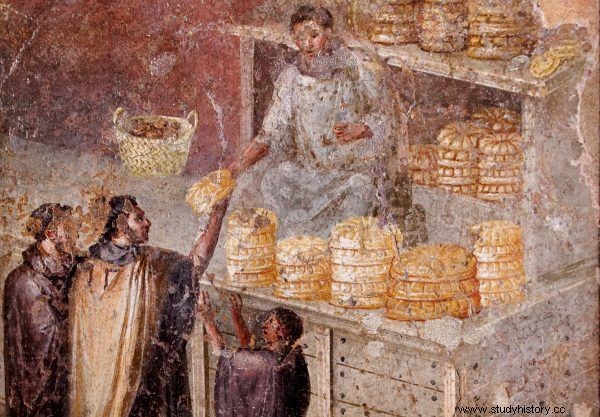
Marcus Licinius Crassus, the richest Roman of the republic era, could easily feed for months tens of thousands of representatives of the Roman poor (the picture shows a fresco from Pompeii.
For a man like Crassus maintaining the poor Roman mass of several tens of thousands for three months was a gesture that was included in the costs of the election campaign . If he wanted, he could buy 60,000. ha of fertile land, support five legions (approx. 30 thousand people) for four years or possibly cover the annual budget of the republic.
By comparison, Bill Gates in his heyday would have been able to finance "only" 1/30 of US spending. However, given the ratio of the income of both rich men to the average earnings of their time, economist Branko Milanović concluded that the American was twice as wealthy.
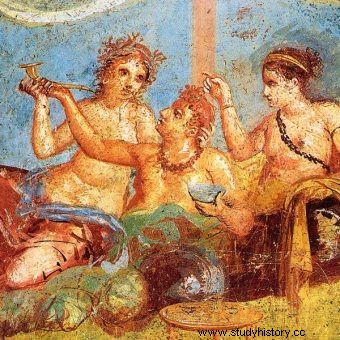
Roman banquet on the Pompeii fresco.
More important than this contractual data is that in just 70 years since the fall of Carthage (146 BCE) the wealth of the richest Romans has increased several dozen times . A profound culture shock was experienced on the Tiber River, and it is no wonder that many of them turned their heads.
Investments in "human capital"
Even under Cicero, having several dozen slaves only as domestic servants was a kind of requirement in good company. The elite competed in dressing these unfortunates in the strangest outfits and assigning them the narrowest possible specializations. For example, not stepping down from his master on the step of nomenklator he suggested the names of people he met on the street and announced the current time regularly.
The best occasion to show off a trained army of servants, however, was provided by lavish feasts. Every smallest activity had its separate performer, including following guests with potty pans or vomit utensils .

Roman slaves serving their masters on a mosaic from the 2nd century C.E.
Anyway, the use of personnel was subject to fashions. Carefully selected handsome boys ( capillati ) gained special recognition ) "For pouring wine". After the meal, the hands were gladly wiped on their long curly hair and the sexual qualities of these young men were appreciated even more.
How easy it was to fall into ridicule is illustrated by the case of a certain Calvisius Sabinus, who spent a fortune on slaves who knew Homer's works by heart. Their task was to suggest the text to their master, when he "delighted" the guests with another performance.
Pearls before hogs?
As already mentioned, the Romans initially supplied themselves with works of art in order to drain the conquered provinces. The wicked Greeks noted the conquerors they were not guided by aesthetic values, but rated the artists' products only according to size and price .
The image of the ignorant nouveau riche is confirmed by the anecdote about L. Mummiusz. He warned the sailors he had commissioned to remove the masterpieces from the devastated Corinth that if any of the paintings were damaged, they would have to replace it with a copy at their own expense.
It should come as no surprise, then, that the elites on the Tiber saw nothing wrong with reworking classical works. This fate befell, among others statue of Alexander the Great by Lysipus, "adjusted" in such a way that at least the face resembles Caesar.
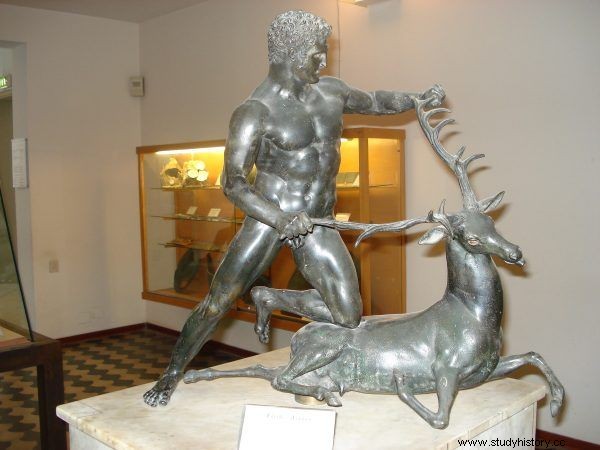
Hercules grabs a Kerinean doe, probably a Roman copy of a sculpture by Lysipo (photo:G. dallorto).
Simultaneously with this taste in art, a fashion for all kinds of peculiarities of nature was born. Plutarch mentions that in his day, the highest auction prices were obtained for slaves with unprecedented disabilities. Over time a separate market was created in Rome, to which dwarfs, giants, hermaphrodites, limbless ones were brought etc.
It was fate to entertain the guests with clumsy demonstrations of fights and acrobatics. Their other task was to stand like statues in the strangest poses. Some of them ended up as sexual toys of their masters. Some have the disgusting practice of keeping infant slaves in tight crates to induce dwarfism.
Carnal pleasures
Bringing in the form of captive Greek cooks in 189 BCE was considered the reason for the abandonment of the original moderation of Roman cuisine. A full list of the richest drinks and dishes available on the tables of Romans would probably be too boring. We will find there not only caviar, 200-year-old wines, the famous foie gras , but also baked flamingo tongues and hare fetuses .
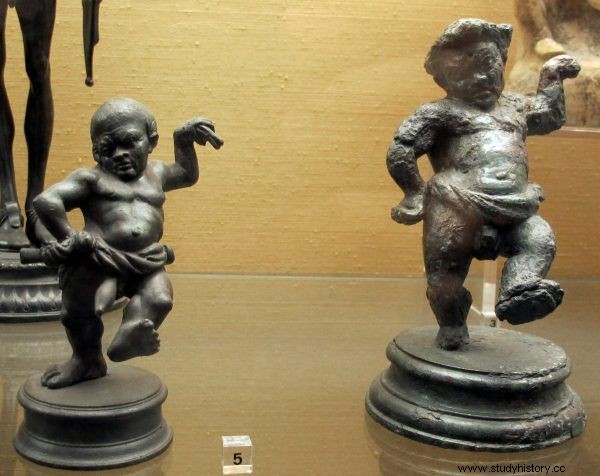
Roman statues of dancing dwarfs (photo:Sailko, CC BY-SA 3.0).
Snobbery ordered to eat it all in stuffy rooms with costly fragrances. Nobody was surprised at adding them to the dishes, but creativity was always appreciated. Hence, the host made a sensation for the emperors, who used pigeons bathed in fragrant oils to spread perfume over the heads of delighted guests.
Of course, the daily attractions included sexual exploitation of slaves of both sexes . It was so natural that when young Crassus was forced to camp in Spanish caves for several months, his friends provided him with a couple of plump slaves to kill boredom.
In ancient times, violence and sex essentially went hand in hand. Remember that we are talking about people who were able to enjoy their meal by watching the throats of convicts being cut , torture of slaves or bloody cockfights equipped with blades mounted on the legs.
Peaceful village…
The Roman aristocracy, as a rule, detested wages. The only worthy occupation in her understanding was agriculture. The writers of that time left us malicious descriptions of many an avid agronomist. The peculiar fascination among the rich with fishponds was eagerly mocked.
Lucius Crassus, a censor in 92 BCE, decorated his favorite eels with the finest jewelry and wore a sincere mourning for the loss of each pet. The infamous Wediusz Pollion in the days of Augustus fed his lampreys with the bodies of slaves . Compared to this innocent quirk, it seems watering vast tree plantations with wine practiced by Quintus Hortensius.
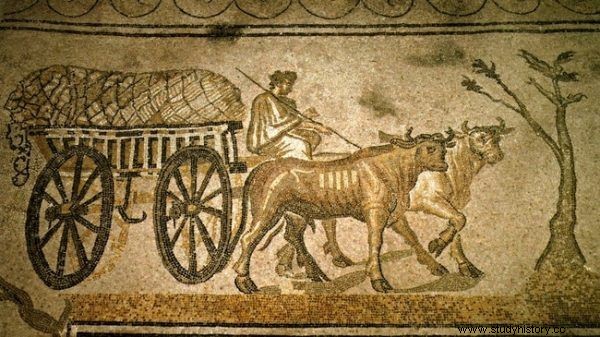
Wealthy Romans liked to flee to the countryside, but disgusted with manual labor (mosaic from the 2nd century CE).
Most of the rich, however, went to the countryside to escape from a foul, crowded, and in the summer months horribly suffocating Rome. Baje was the most fashionable destination of the nouveau riche at that time. This piece of the Gulf of Naples, famous for its hot springs and sensual atmosphere, has transformed over time into a real resort densely dotted with luxurious villas.
These youth today!
The corruption of youth, the object of criticism of the moralists of every age, was an extremely grateful topic in the decline of the republic. From Polybius up to the time of Tertullian, the image of effeminate youths succumbing to every foreign fashion returns regularly. .
They strolled with feminine steps in transparent tunics, disjointed bright togas wandering on the ground, heavy jewelry draped over them. They wore long and neatly curly hair, and at other times they smoothed it with oil. They spent hours waxing and trimming their beards.
According to Marcjalis, the richest ones allowed themselves specially perfumed pastilles to freshen the breath or to apply aluminum salts to the skin, one of the ingredients of antiperspirants to this day.
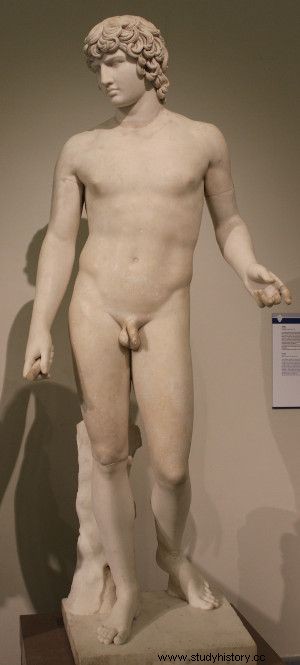
Ah, those effeminate Roman boys! (Photo:Miguel Hermoso Cuesta, CC BY-SA 3.0).
The Romans also looked askance at the youth's fascination with Greek athletics. They considered the pursuit of an ideal figure a manifestation of narcissism as unworthy of the citizen and unproductive. This harsh assessment was shared, among others, by the authority of Galen's measure that equated athletes to pigs.
Today, however, sport seems to be much better than alternatives. In Nero's time, the favorite pastime of unscrupulous youths was night escapades, during which people of the lower class were mistreated with impunity, women were raped and property was destroyed.
***
The nature of the available sources makes the picture presented above appear exaggerated. Regardless of this, it is worth noting that the theories that have emerged today linking the fall of the Roman Empire with the corruption of its inhabitants ignore the obvious fact that depravity reached its highest level during the empire's heyday.
Bibliography:
- Joan Alcock, Food in the Ancient World , Greenwood Press, Connecticut – London 2006.
- John Percy Vyvian Dacre Balsdon, Romans and Aliens , Duckworth, London 1979.
- Keith Bradley, Slavery and Society at Rome , Cambridge University Press, Cambridge 1994.
- The Cambridge Economic History of the Greco-Roman World , ed. Walter Scheidel, Ian Morris, Richard Saller, Cambridge University Press, Cambridge 2008.
- Constance Classen, David Howes, Anthony Synnott, The cultural history of smell , Routledge, London – New York 2003.
- Emiel Eyben, Restless Youth in Ancient Rome , Routledge, London – New York 2005.
- Peter Garnsey, Food and Society in Classical Antiquity , Cambridge University Press, Cambridge 1999.
- Arthur Keaveney, A Life , Routledge, London – New York 1992.
- Ray Laurence, Roman Passions. A History of Pleasure in Imperial Rome , Continuum, London 2009.
- Bruce Marshall, A Political Biography , Adolf Hakkert Publisher, Amsterdam 1976.
- Ida Ostenberg, Staging the World. Spoils, Captives, and Representations in the Roman Triumphal Procession , Oxford University Press, Oxford 2009.
- William Westermann, The Slave Systems of Greek and Roman Antiquity , The American Philosophical Society, Philadelphia 1955.
